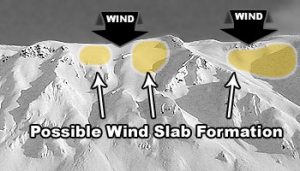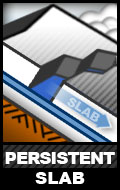Avalanche Danger Forecast
Issued Thursday, February 11, 2021 at noon for the greater Anchorage area Western Chugach Mountains (i.e. Chugach State Park). View map of primary forecast area here.
Avalanche danger will be moderate this weekend.
A danger rating of “moderate” in no way implies “safe” avalanche conditions and 34% of avalanche fatalities occur when the danger rating is moderate. Tragically, three died in a Chugach State Park avalanche-related accident Tuesday, February 2, 2021 when the danger rating was moderate.
Small wind slabs and small to medium sized persistent slabs are the primary avalanche problems. Cornice-related dangers also exist in some areas.
Mountain Weather:
Friday: decreasing clouds, alpine temps in the teens to low 20s, light to moderate east to south wind
Saturday: sunny, alpine temps in the teens to lows 20s, light to moderate east to south wind
Sunday: increasing clouds (more so in southern and eastern areas of the park where there’s a chance of light snow later), alpine temps in the teens to low 20s, light to moderate east to south wind
Discussion:
Light snowfall and strong winds in the upper elevations during the past forecast period created new wind slabs and stressed existing persistent slabs. A few to several inches of new snow had accumulated in some upper elevation areas by Wednesday evening and this snow was accompanied by periods of strong wind that redistributed it into widespread fresh wind slabs ranging from inches to feet in thickness. Temperatures have been warmer and while this has helped new wind slabs to bond and stabilize, they were still very reactive to human triggers in both the North Fork and South Fork areas of Eagle River Wednesday. Wind slabs will continue to form on upper elevation leeward terrain through Thursday night.
Going into the weekend, avalanche danger will decrease as no significant weather is expected. However, due to persistent weak layers (primarily near surface facets and basal weak layers), human triggered avalanches will be possible on terrain steeper than 35º.
Avalanche Problems:
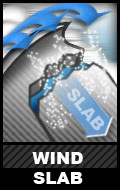 Human triggered wind slabs up to D2 in size are possible above 2500′ on leeward terrain steeper than 35º.
Human triggered wind slabs up to D2 in size are possible above 2500′ on leeward terrain steeper than 35º.
Strong winds (primarily east to south) through Thursday night will continue to build fresh wind slabs on leeward, upper elevation terrain. Additionally, localized moderate wind (primarily east to south) in the upper elevations through the weekend may continue to build fresh wind slabs.
Near surface snow prior to light snowfall Tuesday-Thursday was very faceted and weak from cold temperatures earlier this week and last. This created a persistent weak layer near the surface to which wind slabs formed this week have struggled to bond.
Active wind loading, recent avalanches, and shooting cracks are red flag indicators of wind slab danger. Wind slabs are most likely to exist below corniced areas and along the lee sides of ridges and cross-loaded features like gullies:
Relatively densely-packed (firm and “punchier” feeling) snow and pockets of deeper snow (especially with a bulbous or fat appearance) are indicators of wind slabs. If you look closely at the snow surface you may be able to distinguish where wind slabs exist due to the snow having a more textured, densely-packed, consolidated, cohesive, and/or striated appearance.
Pole probing and hand pits are a quick and effective means of assessing this problem as you travel. Use pole probing to quickly feel out areas of denser, wind-packed snow overlying looser and weaker snow. Use hand pits to quickly assess how near-surface layers of snow are bonded.
Digging a snowpit and conducting a compression test and/or extended column test will provide an even better assessment of bonding and instability before you travel on terrain of consequence.
You can also assess wind slab instability via safer “test slopes” that are representative of higher consequence terrain.
Human triggered persistent slabs up to D2.5 in size are possible above 2500′ on terrain steeper than 35º. While persistent slabs exist on all aspects, expect the problem to be the most pronounced on shadier and colder northerly aspects (where an even more drastic temperature gradient has further exacerbated weakening of the snowpack from the very cold weather of recent weeks).
The persistent slab problem is lower probability, but potentially much higher consequence, than the wind slab problem. Persistent slabs triggered this forecast period may be hard slabs that break deeper down in the snowpack and release above and around a human trigger (rather than at the trigger’s feet) which can make escape difficult. Hard slab avalanche debris is also more likely to cause trauma than debris from soft slabs.
Be on the lookout for red flag warnings of persistent slab danger: recent avalanches, collapsing (aka “whumphing“), and shooting cracks.
Diverse and widespread persistent weak layers exist in the snowpack. Faceted snow exists above and below crusts in some areas, sandwiched between wind packed layers in many areas, and a basal weak layer of advanced facets and depth hoar is widespread. Surface hoar was been observed in some areas earlier this week and last and it may have been buried intact in isolated mid elevation locations where it could be problematic. While dangerous terrain where intact buried surface hoar exists is likely very limited, keep it in mind if you’re traveling around lower to mid elevation terrain traps.
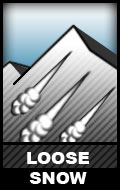 Dry loose snow avalanches are possible above 3000′ on steep terrain (38º+) across all aspects. Human triggered sluffs are possible in isolated, wind-sheltered upper elevation areas and naturally triggered spindrift is possible on steep upper elevation terrain if it’s windy.
Dry loose snow avalanches are possible above 3000′ on steep terrain (38º+) across all aspects. Human triggered sluffs are possible in isolated, wind-sheltered upper elevation areas and naturally triggered spindrift is possible on steep upper elevation terrain if it’s windy.
While these relatively small avalanches (D1) aren’t much of a concern in regard to burial, they do have the potential to cause a fall or loss of control. While not likely, it’s possible that a loose snow avalanche could trigger a larger wind or persistent slab as it descends a slope.
Don’t let a loose snow avalanche catch you off guard. Manage your sluff if descending steep terrain via ski or snowboard. If it happens to be windy and you’re climbing steep and/or exposed terrain, be mindful of the potential for heavy spindrift that could knock you off your feet and take you for a ride.
Human triggered cornice falls are possible this weekend. Cornices are large in some areas above 3000′, recent strong winds have further enlarged them, and they may be more prone to human triggered failure this weekend from recent wind loading.
Give the edge of overhanging cornices a wide berth and don’t approach the edge of a ridge line to look down slope unless you’re sure it’s not corniced. Cornices can break off further back than expected (even beyond the true edge of the mountain ridge beneath the snow surface).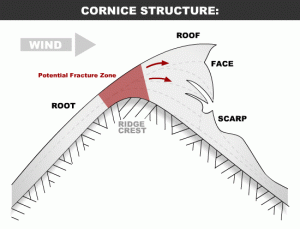
Terrain management is always the best way to deal with avalanche problems: eliminate or reduce your exposure to terrain capable of producing an avalanche. Before traveling on or under terrain that has the potential to avalanche think about the consequences and have a plan (to escape the avalanche, for re-grouping, and rescue).
Always be mindful of terrain traps that can make even a small avalanche deadly.
Click the hyperlinks and icons to learn more.
Please let us know what you’re seeing by tagging us on Instagram @anchorage_avalanche_center, submitting an observation, sending an email to info@anchorageavalanchecenter.org, or via FaceBook message. All observations help us provide the public with a better forecast product (no matter how basic). We can keep your observation confidential, and only use the information to inform forecast products.


